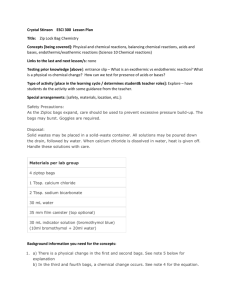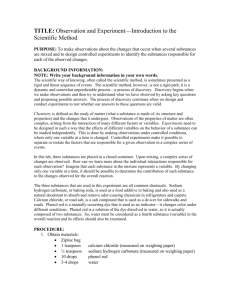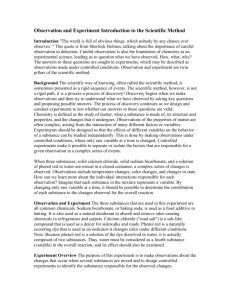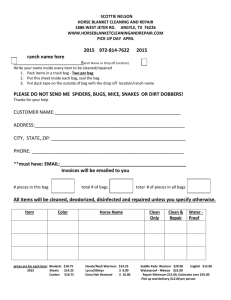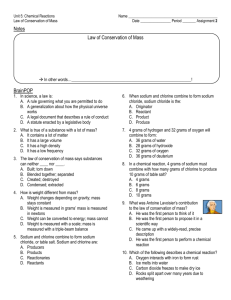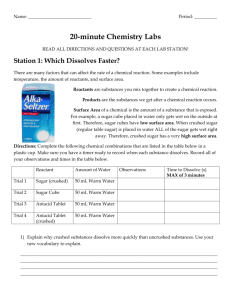4-2 Zip Lock Bag Chem 4-2 zip lock bag chem
advertisement
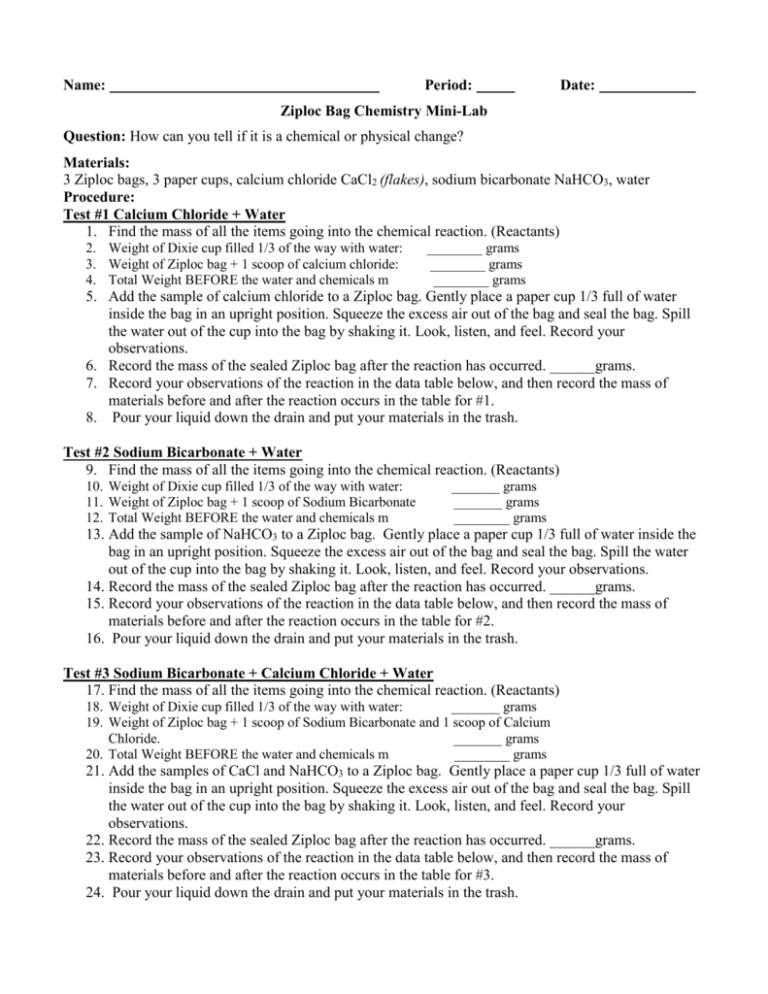
Name: Period: Date: Ziploc Bag Chemistry Mini-Lab Question: How can you tell if it is a chemical or physical change? Materials: 3 Ziploc bags, 3 paper cups, calcium chloride CaCl2 (flakes), sodium bicarbonate NaHCO3, water Procedure: Test #1 Calcium Chloride + Water 1. Find the mass of all the items going into the chemical reaction. (Reactants) 2. Weight of Dixie cup filled 1/3 of the way with water: 3. Weight of Ziploc bag + 1 scoop of calcium chloride: 4. Total Weight BEFORE the water and chemicals m ________ grams ________ grams ________ grams 5. Add the sample of calcium chloride to a Ziploc bag. Gently place a paper cup 1/3 full of water inside the bag in an upright position. Squeeze the excess air out of the bag and seal the bag. Spill the water out of the cup into the bag by shaking it. Look, listen, and feel. Record your observations. 6. Record the mass of the sealed Ziploc bag after the reaction has occurred. ______grams. 7. Record your observations of the reaction in the data table below, and then record the mass of materials before and after the reaction occurs in the table for #1. 8. Pour your liquid down the drain and put your materials in the trash. Test #2 Sodium Bicarbonate + Water 9. Find the mass of all the items going into the chemical reaction. (Reactants) 10. Weight of Dixie cup filled 1/3 of the way with water: 11. Weight of Ziploc bag + 1 scoop of Sodium Bicarbonate 12. Total Weight BEFORE the water and chemicals m _______ grams _______ grams ________ grams 13. Add the sample of NaHCO3 to a Ziploc bag. Gently place a paper cup 1/3 full of water inside the bag in an upright position. Squeeze the excess air out of the bag and seal the bag. Spill the water out of the cup into the bag by shaking it. Look, listen, and feel. Record your observations. 14. Record the mass of the sealed Ziploc bag after the reaction has occurred. ______grams. 15. Record your observations of the reaction in the data table below, and then record the mass of materials before and after the reaction occurs in the table for #2. 16. Pour your liquid down the drain and put your materials in the trash. Test #3 Sodium Bicarbonate + Calcium Chloride + Water 17. Find the mass of all the items going into the chemical reaction. (Reactants) 18. Weight of Dixie cup filled 1/3 of the way with water: _______ grams 19. Weight of Ziploc bag + 1 scoop of Sodium Bicarbonate and 1 scoop of Calcium Chloride. _______ grams 20. Total Weight BEFORE the water and chemicals m ________ grams 21. Add the samples of CaCl and NaHCO3 to a Ziploc bag. Gently place a paper cup 1/3 full of water inside the bag in an upright position. Squeeze the excess air out of the bag and seal the bag. Spill the water out of the cup into the bag by shaking it. Look, listen, and feel. Record your observations. 22. Record the mass of the sealed Ziploc bag after the reaction has occurred. ______grams. 23. Record your observations of the reaction in the data table below, and then record the mass of materials before and after the reaction occurs in the table for #3. 24. Pour your liquid down the drain and put your materials in the trash. Data: Observation of mixing... What did you see happen, did you feel any change in temperature? Record all your observations below! #1 Calcium chloride and water #2 Sodium bicarbonate and water #3 Sodium bicarbonate and calcium chloride How does it change? How does it change? How does it change? Mass of Reactants _____g Mass of Reactants _____g Mass of Reactants _____g Mass of final product ____g Mass of final product ____g Mass of final product ____g Change in mass _____g Change in mass _____g Change in mass _____g 1. SPECIFY which changes you observed were chemical and/or physical JUSTIFY YOUR ANSWER WITH EVIDENCE FROM THE LAB! Sodium bicarbonate and Calcium chloride and water Sodium bicarbonate and water calcium chloride Chemical changes? Chemical changes? Chemical changes? Physical changes? Physical changes? Physical changes? 2. What sort of things signified a chemical change versus a physical change? (For example... If it _____________ it was definitely a chemical change.) 3. What are the possible gases that could be produced in this experiment? Look at the chemical formula for the reactants (stuff you mixed). 4. Did the mass change in any of the reactions from the initial reactants (things you put in) to the final product? (What you had after the reaction) 5. Go to http://www.learner.org/channel/courses/essential/physicalsci/session4/closer1.html or (http://goo.gl/ktNsi2) - What is the distinction between chemical and physical changes? Physical change is when... Chemical change is when...

